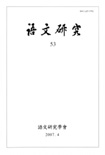- 영문명
- The construction study of the medical books in Gugeupbang type ― Focus on the construction related the prescription
- 발행기관
- 어문연구학회
- 저자명
- 김남경(Nam-Gyeong Kim)
- 간행물 정보
- 『어문연구』語文硏究 第53輯, 389~413쪽, 전체 25쪽
- 주제분류
- 어문학 > 한국어와문학
- 파일형태
- 발행일자
- 2007.04.30

국문 초록
영문 초록
This study is purposed of sampling and analyzing the construction in Gugeupbang type which is in the representative medical books in Gugeupbang type published in the middle Korean period; 『救急方(annotation)』上, 下, 『救急簡易方(annotation)』卷一, 二, 三, 六, 七, 『諺解 救急方』上, 下 and so on.
Gugeupbang type that because of the nature of the medical books classifies into three constructions; symptoms, prescriptions, remedies. This study deals with the prescription constructions.
The prescription constructions express in the imperative sentence. At this time, the surface form is generally [(NP이) NP을 V―].
In Gugupbang type, the constructions related to the prescription are‘먹다, 브티다, ??다, 마시다, ?다, 침주다’ and so on. Next, the result of the const겨ction analysis presents the vocabulary order in the high frequency.
(1) 먹다 : (NP이) NP을 먹-[symptom]…[대상-[+solid][+liquid][+gas]]+[method(pharmacy, dosage, application time)]+먹-먹이- : (NP이) NP란 NP을 먹이-
(2) 브티다 : (NP이) NP를 NP에 브티-[symptoms and the part of wound]···[material]를 + [place-the body parts]에 + 브티-
(3) ??다 : (NP이) NP를 ??-[object-[+solid][+liquid][+gas]]를 + [the treat of the medication(inside the mouth)] + ??-
(4) 마시다 : (NP이) NP를 마시-[object-[+powder][+gas][+l i quid]]를+[dosage], [application time]+마시-
(5) ?다 : (NP이) NP로 NP를 ?-[tool]로 + [the body parts]를 ?-
(6) 침주다 : (NP이) NP를 침주-(NP이) [the body parts]를 침주- + [times][other prescription]
Gugeupbang type that because of the nature of the medical books classifies into three constructions; symptoms, prescriptions, remedies. This study deals with the prescription constructions.
The prescription constructions express in the imperative sentence. At this time, the surface form is generally [(NP이) NP을 V―].
In Gugupbang type, the constructions related to the prescription are‘먹다, 브티다, ??다, 마시다, ?다, 침주다’ and so on. Next, the result of the const겨ction analysis presents the vocabulary order in the high frequency.
(1) 먹다 : (NP이) NP을 먹-[symptom]…[대상-[+solid][+liquid][+gas]]+[method(pharmacy, dosage, application time)]+먹-먹이- : (NP이) NP란 NP을 먹이-
(2) 브티다 : (NP이) NP를 NP에 브티-[symptoms and the part of wound]···[material]를 + [place-the body parts]에 + 브티-
(3) ??다 : (NP이) NP를 ??-[object-[+solid][+liquid][+gas]]를 + [the treat of the medication(inside the mouth)] + ??-
(4) 마시다 : (NP이) NP를 마시-[object-[+powder][+gas][+l i quid]]를+[dosage], [application time]+마시-
(5) ?다 : (NP이) NP로 NP를 ?-[tool]로 + [the body parts]를 ?-
(6) 침주다 : (NP이) NP를 침주-(NP이) [the body parts]를 침주- + [times][other prescription]
목차
Ⅰ. 머리말
Ⅱ. 처방 구문의 설정과 특성
Ⅲ. 처방 구문의 구조 분석
Ⅳ. 맺음말
참고문헌
Abstract
Ⅱ. 처방 구문의 설정과 특성
Ⅲ. 처방 구문의 구조 분석
Ⅳ. 맺음말
참고문헌
Abstract
해당간행물 수록 논문
참고문헌
최근 이용한 논문
교보eBook 첫 방문을 환영 합니다!

신규가입 혜택 지급이 완료 되었습니다.
바로 사용 가능한 교보e캐시 1,000원 (유효기간 7일)
지금 바로 교보eBook의 다양한 콘텐츠를 이용해 보세요!


